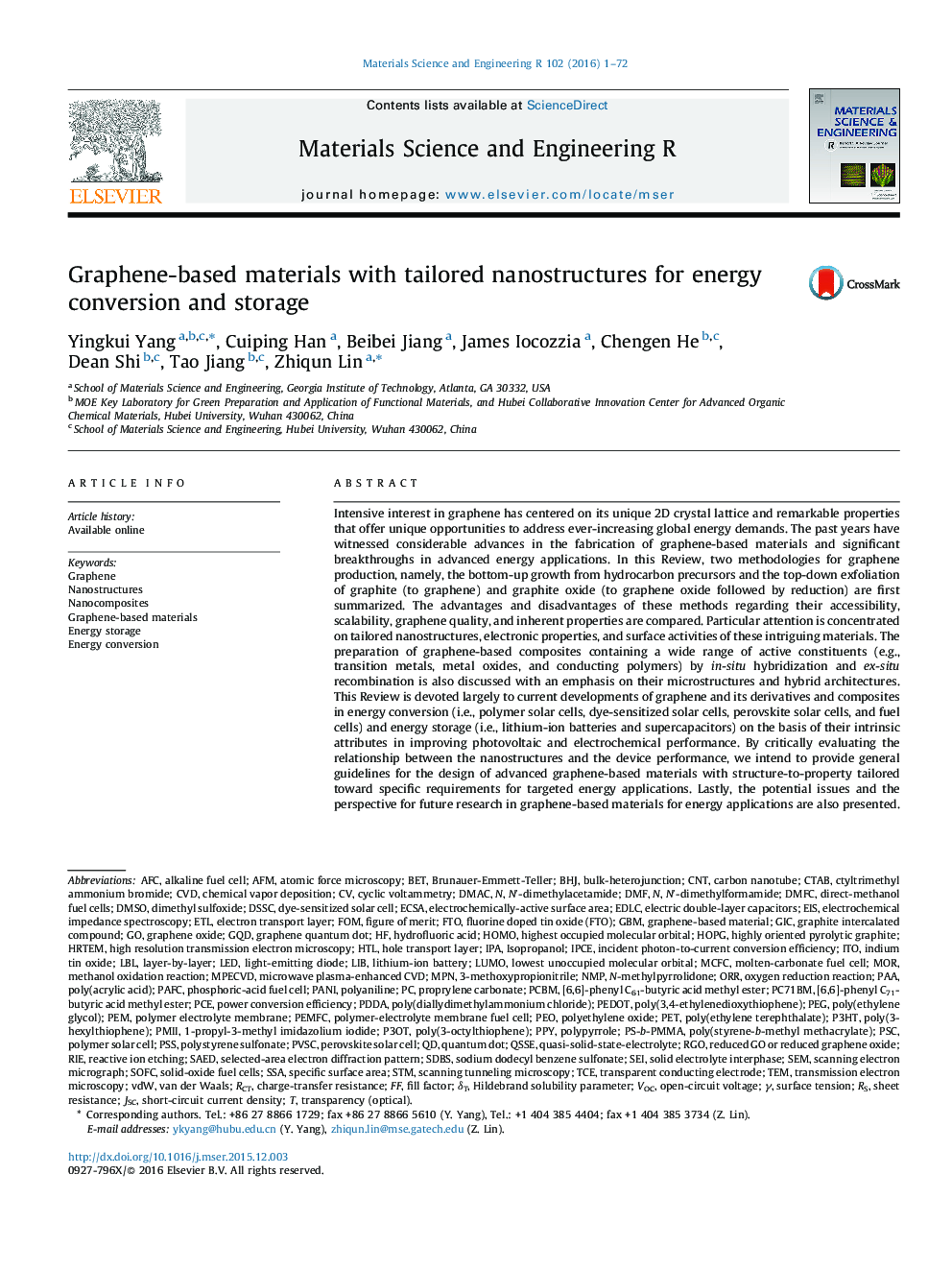| Article ID | Journal | Published Year | Pages | File Type |
|---|---|---|---|---|
| 1532299 | Materials Science and Engineering: R: Reports | 2016 | 72 Pages |
Abstract
Intensive interest in graphene has centered on its unique 2D crystal lattice and remarkable properties that offer unique opportunities to address ever-increasing global energy demands. The past years have witnessed considerable advances in the fabrication of graphene-based materials and significant breakthroughs in advanced energy applications. In this Review, two methodologies for graphene production, namely, the bottom-up growth from hydrocarbon precursors and the top-down exfoliation of graphite (to graphene) and graphite oxide (to graphene oxide followed by reduction) are first summarized. The advantages and disadvantages of these methods regarding their accessibility, scalability, graphene quality, and inherent properties are compared. Particular attention is concentrated on tailored nanostructures, electronic properties, and surface activities of these intriguing materials. The preparation of graphene-based composites containing a wide range of active constituents (e.g., transition metals, metal oxides, and conducting polymers) by in-situ hybridization and ex-situ recombination is also discussed with an emphasis on their microstructures and hybrid architectures. This Review is devoted largely to current developments of graphene and its derivatives and composites in energy conversion (i.e., polymer solar cells, dye-sensitized solar cells, perovskite solar cells, and fuel cells) and energy storage (i.e., lithium-ion batteries and supercapacitors) on the basis of their intrinsic attributes in improving photovoltaic and electrochemical performance. By critically evaluating the relationship between the nanostructures and the device performance, we intend to provide general guidelines for the design of advanced graphene-based materials with structure-to-property tailored toward specific requirements for targeted energy applications. Lastly, the potential issues and the perspective for future research in graphene-based materials for energy applications are also presented. By summarizing the current state-of-the-art as well as the exciting achievements from laboratory research, this Review aims to demonstrate that real industrial applications of graphene-based materials are to be expected in the near future. (1346 references).
Keywords
AFMDMFMCFCCTABSOFCδtPEMFCTCEDMFcCNTMORHRTEMORRPEDOTPolypyrroleSEIPSSLiBPEMBrunauer-Emmett-TellerVOCPPySAEDPAADSSCP3HTBHJFOMN-MethylpyrrolidoneHTLETLPCEIPCESSAMPNLbLAFCSTMPSCRIEGBMIPARCTNMPDMACSDBSGQDGICPS-b-PMMAPCBMHOPGPC71BMPDDAEDLCP3OTECSAGraphene-based materialJscPAFCMPECVDmicrowave plasma-enhanced CVDPMIIpoly(styrene-b-methyl methacrylate)DMSOSolid electrolyte interphasePANIrGOvdWhydrofluoric acidTransparent conducting electrodeHomoreactive ion etchingIndium tin oxidePolyethylene oxideGraphene oxideIsopropanolITOTemLithium-ion batteryIncident photon-to-current conversion efficiencyhighest occupied molecular orbitalEnergy conversionEISShort-circuit current densityElectric double-layer capacitorsFTOlight-emitting diodeDimethyl sulfoxideEnergy storagePower conversion efficiencyChemical vapor depositionCVDLEDSodium dodecyl benzene sulfonateSpecific surface areaPerovskite solar cellDye-sensitized solar cellalkaline fuel cellPolymer solar cellSolid-oxide fuel cellsBETElectrochemical impedance spectroscopyPolymer electrolyte membraneFill factorBulk-heterojunctionElectron transport layerHole transport layerLayer-by-layerLUMOopen-circuit voltageSEMFigure of meritCharge-transfer resistanceSheet resistanceGraphene-based materialsScanning electron micrographHigh Resolution Transmission Electron MicroscopyTransmission electron microscopyScanning tunneling microscopyatomic force microscopyNanostructuresCarbon nanotubeNanocompositesquantum dotGraphene quantum dotmethanol oxidation reactionOxygen reduction reactionCyclic voltammetryVan der WaalsHildebrand solubility parameterPETPoly(3-octylthiophene)Poly(3-hexylthiophene)poly(3,4-ethylenedioxythiophene)PolyanilinePoly(ethylene terephthalate)Poly(ethylene glycol)Polystyrene sulfonatepoly(acrylic acid)PEGPEOSurface tensionLowest Unoccupied Molecular OrbitalGrapheneHighly oriented pyrolytic graphite
Related Topics
Physical Sciences and Engineering
Materials Science
Electronic, Optical and Magnetic Materials
Authors
Yingkui Yang, Cuiping Han, Beibei Jiang, James Iocozzia, Chengen He, Dean Shi, Tao Jiang, Zhiqun Lin,
